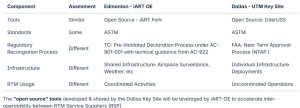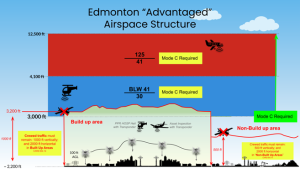The iART Alliance has announced the launch of the Alberta RTM Trials – Operational Evaluation (iART-OE), a Canadian initiative designed to evaluate remotely piloted aircraft systems (RPAS) traffic management (RTM) services in active, real-world scenarios. The project brings together key industry, government, and academic stakeholders to test, assess, and refine RTM capabilities that will be critical to enabling safe Beyond Visual Line of Sight (BVLOS) operations in Canada.
The goals of the project are to establish a UTM system which will enable airspace to 400ft AGL for emergency services and commercial use cases, demonstrate Interoperability compliant with ASTM F3548-21) and ASTM F3411-22a; and develop “pre-validated declaration (PVD) for RTM Service Supplier(s) as defined in AC 901-001.”
iART-OE represents a scalable, standards-based model for RTM deployment in Canada along the lines of the US UTM Implementation programme concept trialled in Dallas . The “open source” tools developed and shared by the Dallas Key Site will be leveraged by iAT-OE to accelerate inter-operatablity between RTM service suppliers (RSP), according to the programme website.

“The use of internationally accepted standards are leveraged by both initiatives,” says the programme website. “The standards for “RSP Interoperablity” and “Network Identification” will lead the technical validation for both initiatives. With each achieving the implementation of each standard at different pace and scale. The path for regulatory recognition has been defined in both jurisdictions. However, the FAA/Dallas initiative has a already achieved acceptance for early stage participants. In Canada, no RSP’s have been recognized under the pending regulations. This initiative will lead the way by providing an optimized sandbox for evaluation and testing.”
“Shared infrastructure will be provided to participating RSP’s to help accelerate inter-operability testing, and regulatory recognition. The shared use of airspace surveillance and weather services will empower operational flight testing activities. The distributed use of RTM systems will be coordinated between the RSP’s. This is a topic of further discussions and negotiations between RSP’s. The coordinated use of flight activities to facilitate inter-operability testing, will be determined in future planning activities.”
According to an alliance press release:
“The iART-OE trials will begin in Sherwood Park, Alberta—a progressive community in Strathcona County and part of the Edmonton metropolitan area. Both Strathcona County and the City of Edmonton are focused on enabling their communities with advanced drone capabilities, particularly in the area of emergency response through Drone as First Responder (DFR) programs….Building on the approach pioneered in the Dallas Keysite, the Alberta RTM Trials will feature industry-led interoperability testing to evaluate and advance cooperative airspace management.”
Two of the principal industry partners are OneSky and AIRmarket. “Together, we are working to establish Canada’s first RTM-enabled cooperative airspace in the Greater Edmonton Region,” say the companies in a press release.”This marks a first in Canada and sets the stage for testing real-world interoperability, coordination, and data exchange between platforms. The results are expected to inform the development of Canada’s broader RTM ecosystem, serving as a foundational step ahead of NAV Canada’s rollout of the rFIMS service.
| Open-source architecture at the heart of the programme
With new Transport Canada regulations coming into effect on November 4th, 2025, service providers—including RTM and Surveillance Data Service Providers (SDSPs)—will be able to seek regulatory recognition for digital services through the Pre-Validated Declaration (PVD) process as defined in AC 901-001. iART-OE is purpose-built to support this process, offering a proving ground for demonstrating, refining, and submitting RTM and surveillance services for formal acceptance. Technical guidance for enabling systems such as Command and Control (C2) and Detect-and-Avoid (DAA) is provided through the AC922 advisory circular series. At its core, iART-OE deploys the first interoperable RTM systems in Canada aligned with international UTM standards, including:
These services are implemented using open-source, cloud-native architectures operationalized through NASA/FAA UTM trials and the Dallas-Fort Worth Key Site—now adapted for Canadian regulatory, airspace, and geographic conditions. Initial deployments focus on enabling Drone as First Responder (DFR)missions within Edmonton’s Advantaged Airspace, effectively creating Canada’s first RTM-Cooperative Airspace Classification Overlay. This urban-class airspace supports safe, compliant BVLOS drone integration alongside crewed aviation. As the program scales, the same RTM framework will support commercial drone operations up to 400 feet AGL, enabling routine BVLOS access for infrastructure inspections, utilities, logistics, and other industrial services.
|
There will be three stages of delivery. This first phase establishes the collaborative framework between the core RSP’s and the operational flight team(s). The RSP’s will consume surveillance and weather data streams within their solutions. The completion of this phase will be triggered by both RSP’s acquiring PVD’s. The Distributed Synchronization Server (DSS) and Automated Rules Testing application(s) will be deployed, in this stage. Phase two will form the foundation for anticipated expansion, based on regulatory recognition for both RSP’s and aircraft. The expansion to support commercial use cases within the airspace is underpinned by aircraft manufacturers producing a Pre-Validated Declaration (PVD) for the associated population density. Phase three will be determined through the execution of phase one and two. “As contemplated, this phase is anticipated to provide a technology and operational ramp towards the future rFIMS services.”
For more information
https://airmarket.io/airmarket-onesky-partnership/
(Image: Edmonton, Alberta – Shutterstock)





